|
Page en Français |
EQUIPMENT
|
My optical tube assembly is an INTES MK-66 bought in June 2003 at Optique Unterlinden (Colmar-FRANCE). It is a MAKSUTOV-CASSEGRAIN RUMAK telescope. It is a F/12 150mm telescope. This telescope is built in Moscow-RUSSIA by INTES PLUS Co which was working in optical warfare systems when URSS was still existing (not to be mixed up with INTES-MICRO which builds the M603, a 150mm F/10 maksutov-rumak telescope).
|
|
 |
||||||||||||||||||||||||||||||||||||||||||
|
|
Good stuff - Optics are excellent (above Lambda/5 PTV and Lambda/30 RMS) and products very sharp images, even when collimation is not perfect. Image luminosity is good. At 360x on planets, images are still very good (theoretical maximum magnification), they have very little degradation in sharpness, and there is still much luminosity. In fact, quite stupid magnifications (up to 750x) are possible on contrasted objetcs like the moon, saturn and double stars. - MK66 is a Maksutov-Cassegrain-Rumak. The Rumak version caracteristic is that it has a separate secondary mirror, and not a simple aluminized dot inside the meniscus as the Meade and Skywtacher maksutovs have (these are Maksutov-Cassegrain-gregory scopes). On this scope, we can perform collimation on the secondary mirror, and also on the primary mirror. Collimation can then be very precise, and this enables to have high resolution images. Collimation cannot be achieved on the great majority of other Maksutovs (Meade, skywatcher have a factory collimation). Another great advantage of the Rumak design is that the curvature radius of the secondary mirror can be different that the meniscus curvature. This enables to have a quite perfect correction of the aberrations on the whole field of view. The field of view is very flat, and image is as sharp on the edge that at the center of the field of view. There is also absolutely no chromatism, and that gives excellent planet views ! - The focus is achieved by moving the primary mirror. It is easy to reach focus, even at high magnifications (360x) and there is no shifting unlike on SCT scopes, and this is a very good thing to perform webcam imaging. - The tube is built entirely in metal and the mechanics are very robust. The only plastic parts are the finder 6 screws ! - The overall performance of this tube is excellent in regadr with it's price ! You've got APO performance for one third of the price !! Bad stuff - The temperature of the tube is long to equilibrate. In winter, when there are big temperature differences between inside and outside my home, it can take up to 1h 1/2 to have pretty good images and 2h to have perfect ones.. - The tube is heavy (6kg), so when it is on it's equatorial mount, it is not so easy to move the whole thing around ! - The focusing knob mouvement is not so smooth as it could be, mainly when turning in intra-focal direction. This is due to the main mirror compression spring and to the grease which is not a high quality one. - Minimum focusing distance is too long (50m) to do some terrestrial observations like bird sighting.
|
|
The secondary collimation is achieved with 3 Philips screws. Each screw is coupled with a spring. The screw pulls the mirror and the spring pushes it. This collimation system is very easy to use and very precise. When you losen one screw, no need to tigh the 2 others. The primary mirror collomation is achieved with 2 groups of 3 screws. The 3 big screw are pulling the mirror and the 3 small ones are pushing it. Collimation is very stable. The tube is equipped with a very efficient baffled dew shield.
|

|
|
|
|
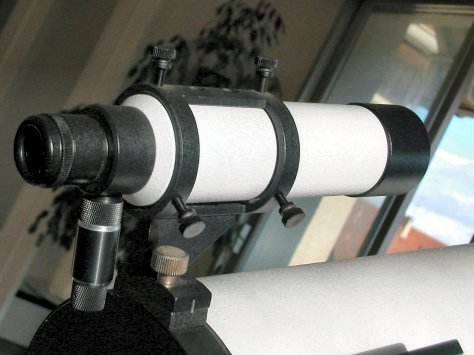 |
There are two mechanical plates on the rear of the tube. One is used to mount the finder scope, the other one is free. The finder is a good quality 7x35 scope with a a reticle that can be lightened. There is a handle on the top of the tube. This is very convenient when you are putting the tube on it's mount. |
My mount is an EQ5 german equatorial mount (made in China) with two driving motors. It is not exeptionnal, but OK for visual observation and webcam imaging.
The tripod is made in aluminium. It's great default is that it is not very tight in rotation.
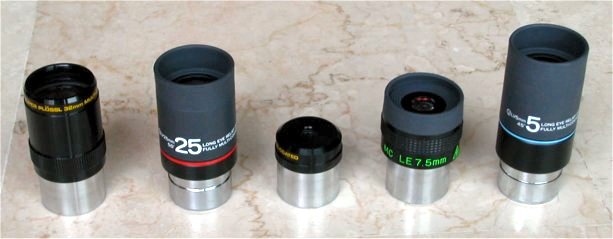
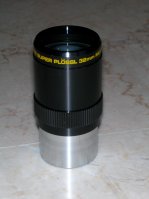 |
MEADE SP4000 32mm 50° field of view. It is an old version of the super-plöss 4000. This version is a "made in japan" version and the optics are superior to the "made in china" version. It is not very sharp on the edges. |
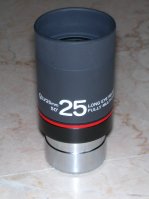 |
VIXEN Lanthanum LV 25mm 50° field of view It is quite sharp on all the field of view. It has a good eye relief and is very confortable to use. Some chromatism in the image.
|
 |
MEADE SP4000 9,7mm 50° field of view. It is an old version of the super-plöss 4000. This version is a "made in japan" version and the optics are superior to the "made in china" version. Image sharpness and contrast are very good. Eye relief is correct. My prefered eyepiece after the takahashi LE 7.5. |
 |
TAKAHASHI LE 7,5mm 50° field of view This is an Erfle eyepiece. Image is razor sharp with the MK66 ! It reveals planetary details that are unvisible in my other eyepieces. Contrast and luminosity are very good. This is my best one ! |
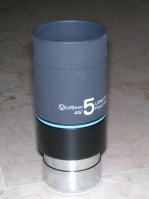 |
VIXEN Lanthanum LV 5mm 50° field of view Image sharpness is correct. Eyerelief is very good because it has a barlow lens inside.. |
Under construction...
INDEX - EQUIPMENT - MOON PICTURES - JUPITER PICTURES - SATURN PICTURES - MARS PICTURES - URANUS PICTURES - DOUBLE STARS PICTURES - LINKS


